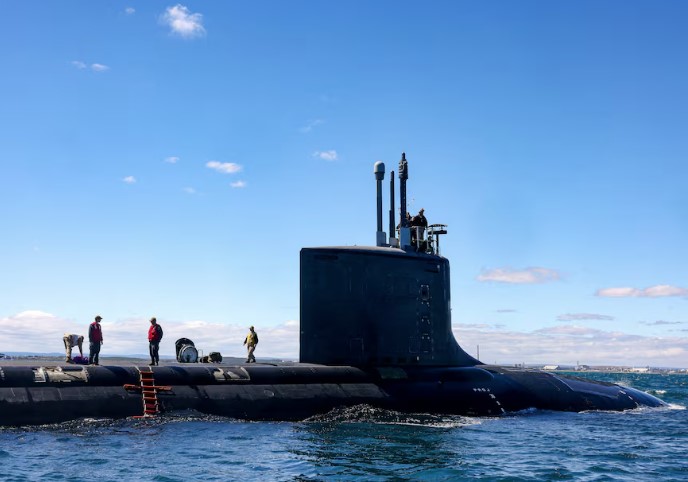Beneath the waters off the Western Australian coast, sonar operators aboard a U.S. Navy Virginia-class submarine are adjusting to a new environment. The quiet hum of advanced sonar systems is accompanied by the chatter of dolphins as the submarine navigates unfamiliar territory.
Virginia-Class Submarines in Australian Waters
These submarines are among the most technologically advanced warships in the world, replacing traditional periscopes with photonic masts that use high-resolution cameras to scan the ocean surface. Crew members use video game-style joysticks to control these systems, reflecting the modernized nature of naval warfare.
Life inside these submarines is highly disciplined and challenging. Sailors can spend up to 100 days underwater without seeing sunlight, cut off from regular communication with their families. Limited email access allows only intermittent updates from home, as maintaining stealth is a top priority. The crew operates under the philosophy that their mere presence serves as a deterrent, making adversaries think twice before taking aggressive actions.
The USS Minnesota, currently on a training exercise from its home port in Guam, is a preview of the growing U.S. naval presence in Australia. Under the AUKUS agreement, four Virginia-class submarines will be stationed at HMAS Stirling, a naval base in Western Australia, starting in 2027. This initiative is part of a broader defense strategy, as Australia strengthens its naval capabilities with the support of the United States and the United Kingdom.
To accommodate this expansion, HMAS Stirling is undergoing a $5 billion upgrade. By mid-year, 50-80 U.S. naval personnel will be stationed there, with numbers expected to rise into the hundreds in the next two years. This increase in U.S. military presence marks a shift in regional security, positioning Australia as a key partner in Indo-Pacific defense operations.
Strategic Importance of the Indian Ocean
The growing presence of U.S. submarines in Australian waters is not just about military expansion; it is a response to increasing naval activity in the region. The Indian Ocean has become a strategic focal point, with rising global interest in its security.
AUKUS Tests Game-Changing Autonomous War Machines!
A recent example of this occurred when a Chinese navy task group circumnavigated Australia, conducting live-fire drills off the east coast. These drills disrupted commercial airline routes and coincided with the USS Minnesota’s port call in Western Australia. Australian officials viewed the maneuvers as a sign of China’s intent to operate more frequently in the region.
For the United States, maintaining a strong naval presence in the Indo-Pacific is crucial. The shift in focus from the Middle East and Europe to this region has led to increased investment in submarine forces. Despite overall budget cuts in U.S. defense spending, the Virginia-class submarine program has been prioritized. These submarines are considered essential for maintaining security in critical waterways and ensuring stability in contested areas.
Testing Trilateral Maritime Capabilities: A Key Step Toward AUKUS Collaboration
As part of the AUKUS partnership, Australia will acquire two used Virginia-class submarines in the next decade and collaborate with Britain to develop a new class of nuclear-powered submarines. These advanced vessels will eventually replace Australia’s ageing diesel-powered fleet, providing the country with a more capable and stealthy naval force. Nuclear-powered submarines can stay submerged for much longer than diesel-powered ones, making them a strategic advantage in modern naval operations.
U.S. and Australian Military Cooperation
To prepare for the arrival of nuclear-powered submarines, Australia has already begun training personnel in the United States. Currently, 115 Australian sailors are participating in the U.S. nuclear navy training program, gaining experience aboard Virginia-class submarines. Additionally, 130 Australian personnel are undergoing specialized training in nuclear submarine maintenance at Pearl Harbor in Hawaii. This intensive training process is essential to ensuring that Australia is ready to operate and maintain the sophisticated submarines it will acquire.
The USS Minnesota’s move from Hawaii to Guam last year also signals a shift in U.S. naval strategy. Guam, being closer to Taiwan, serves as a key forward-deployed submarine base, allowing faster response times in the region. The United States sees submarines as a crucial element of deterrence, ensuring that key areas remain protected against potential threats.
With tensions rising and military activities increasing in the Indo-Pacific, the expansion of submarine forces in Australia represents a major shift in regional security. The growing presence of advanced submarines in Australian waters reflects the changing nature of global defense strategies, reinforcing the importance of naval power in maintaining stability in the region.

